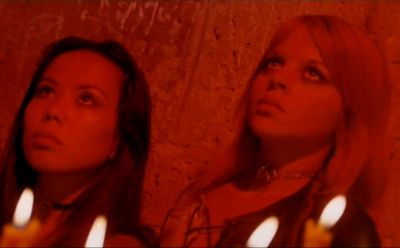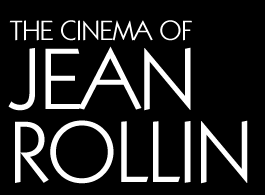The works of French director Jean Rollin have been difficult if not altogether impossible to see in America. However, reference books, such as Phil Hardy's The Overlook Film Encyclopedia: Horror, frequently describe Rollin's movies in glowing terms. Hardy describes Lips of Blood as "beautifully macabre" and Requiem For a Vampire is described as a "deliriously lyrical sadean poem." Meanwhile, Cathal Tohill and Pete Tombs' excellent Immoral Tales devotes nearly 60 pages to Rollin's career while reserving its highest praise for Rollin's films and describing him as "a weaver of dreams."
Several of Rollin's films have been available on video, but usually in badly duped copies from fly-by-night mail-order companies. Any hope of an official release of Rollin's films from high-quality source material seemed to be a pipe dream. However, a British company, Redemption Films Ltd., has recently been releasing his films on video in the UK. And now Redemption Films has entered a distribution deal with Image Entertainment to release Rollin's films on DVD in America.
Seven Rollin movies are now available on DVD from Image Entertainment: The Shiver of the Vampires, Requiem for a Vampire, The Demoniacs, Fascination, The Night of the Hunted, Lips of Blood, and The Living Dead Girl. Additional releases--including The Rape of the Vampire, The Nude Vampire, Lost in New York, and The Sidewalks of Bangkok--are tentatively scheduled for release later this year.
A listing of Rollin's film titles hints at the strange images on display in his movies--but it only hints. Within the films themselves, a bounty of exotic, sadistic perversities awaits: lovers are sealed in a coffin that drifts out to sea, a marriage ceremony weds a pair of vampires, a female vampire frantically slices open her arm and drinks her own blood, a coven of vampires chain women victims to the walls of a dungeon, a crew of pirates tortures the survivors of a shipwreck, upper-class women convene at a chateau for ritualistic blood drinking, and that's just for starters.

From The Shiver of the Vampires.
(© 1999 Image Entertainment. All rights reserved.)
Rollin's movies frequently tell conventional horror stories. The Shiver of the Vampires, for example, gives us one of the most familiar of all horror plots: a newlywed couple spends an evening at a castle and discovers it is crawling with vampires. But Rollin tells his stories in the most unconventional of ways. In Shiver, the vampires become intellectual hippies who spout bizarre theories about the history of religion in Europe. His movies contain elements of horror cinema, but Rollin insists he does not make horror films. Not surprisingly, because his movies tend to defy the expectations of audiences, reactions to his movies can be volatile. His first full-length film, The Rape of the Vampire, was greeted with violent protests in Paris. And throughout his career, his movies have encountered hostile critical reactions. The French Board of Control (which certified movies for release in France) described Rollin's The Demoniacs as "a complete stupidity."
Compounding the problem, Rollin frequently solicits expressionistic, extravagant performances from his (largely inexperienced) actors. Or he allows the actresses to remain virtually immobile--like cold, beautiful sphinxes. It's no coincidence the Rollin movie that arguably received the best reception from audiences and critics--Fascination (1979)--also features the most naturalistic performances of any Rollin movie to date.
Rollin's movies did not achieve widespread cult status because of their acting. Audiences, instead, have reacted to Rollin's images. While the performances frequently have the same effect as fingernails on a chalkboard, the images themselves tend to stick in your mind for long after the final fadeout. Cathal Tohill and Pete Tombs described Rollin's cinema this way: "[Rollin's movies] look back to a romantic, doom laden past, filled with displaced vampires and uncanny beauty…His best films have a bleached out intensity, a unique mood all of their own."
His movies combine pulp imagery with the plot mechanics of serials. You'll find American models, such as The Perils of Nyoka (remember the scene where the native tribe strings up Nyoka over a fire pit?), combined with the classic French serial tradition of Louis Feuillade, as epitomized by Les Vampires and Fantomas. In contrast to his enticingly hyperactive subject matter, Rollin's approaches storytelling with a cool, dispassionate eye. Whereas directors such as Jose Larraz (Vampyres) and Jess Franco (Succubus) indulged in intensely emotional subject matter and images, Rollin preferred languid, morbid contemplation. So while his subject matter involved comic book aesthetics, Rollin filtered his storytelling through a high art sensibility.
These contrasts in style and subject matter tend to elicit confusion and consternation from audiences; however, for those people who can appreciate Rollin's wildly idiosyncratic and non-conformist vision, his movies are filled with morbid delights.
NEXT PAGE »
Go to:
Introduction
The Shiver of the Vampires
Requiem for a Vampire
The Demoniacs
Lips of Blood
Fascination
The Night of the Hunted
The Living Dead Girl
ABOUT THE DVDs





